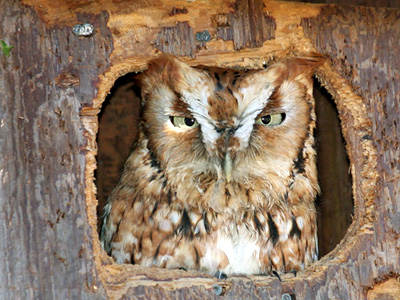Winter Nest Box Maintenance
Now that nesting season is over, it’s time to take care of your nest boxes.

Bluebird nest box with old nest material; photo by J.N. Stuart, Flickr CC by NC ND 2.0
This is a great time of year to inspect any nest structures that you have and replace any potentially rotted material.
Below are some additional recommended steps to take:
- Remove all old nesting material and dispose of material away from nest box to avoid attracting predators. Don’t reach directly into the nest box unless you can see inside clearly. Be sure to wear gloves and possibly a face mask.
- Use a stiff brush to scrape the interior. If drain holes are plugged with debris, be sure to unclog them.
- If bees or wasps have taken over, remove the nest. To prevent them from establishing nests in the future, add a thin layer of nonstick cooking spray or rub an unscented bar of soap onto the inside surface of the roof. This will create a slippery surface between the insects and the roof of the box.
- If desired, disinfect the nest box with an enzyme solution or a 10 percent bleach solution. As alternatives, you can mix 1 cup of vinegar with a gallon of water for disinfectant, or you can mix 3 cups of hot water, 3 tablespoons of baking soda and 3 tablespoons of lemon juice in a spray bottle. After disinfecting, be sure to keep nest box open for at least a day to ventilate and dry out.
- Remove the nest box in the winter and place in a sheltered area, like a garage, or leave it up for a winter roost site. If you choose to leave the box up, make sure to check and clean it before nesting season begins.
- Small mammals such as mice may take up residence in your bird boxes in the late fall through winter. These nests should be removed before spring songbird season. Wear gloves and a dust mask when cleaning out old mouse nests. To discourage nesting mice, when the nesting season is over, open the front or side of a songbird house and leave it that way until spring.
- Inspect and retighten all screws or hanging hardware.
- Repair and/or replace any predator guards.

Eastern screen owl; photo by George Jett
Recommended Nest Box Replacement Times:
- January: Most owl nest boxes should be repaired and replaced by January. For many owl species, like screech owls and barn owls, it is best to add new wood chips to the bottom of the box. Do not use sawdust, as it will hold moisture when it gets wet.
- February: American kestrel and Eastern bluebird boxes should be repaired and replaced by mid-February.
- March: Inspections and repairs should be finished by the first week in March for most songbird and Wood duck boxes.
For more information on choosing nest boxes, proper design and placement, check out NestWatch through Cornell. Consider joining and submitting bird nesting data to the national database.
Author’s Note
Welcome to the winter edition of the HabiChat, our quarterly backyard wildlife habitat newsletter from the Wild Acres program. Winter is usually a time of dormancy for many species. However, quite a few critters are active during this time of year! This issue includes information on one of our winter visitors—the yellow-bellied sapsucker—as well as tips on taking kids out for a winter wildlife safari. It also contains information on winter nest box maintenance tips.
In addition, the University of Maryland Extension’s Woodland Stewardship Education has several upcoming events that may be of interest to backyard enthusiasts. Registration for the spring session of The Woods in Your Backyard online course is now open. This self-paced, non-credit course runs 10 weeks from March 7-May 21, 2018. The course will help landowners convert lawn to natural areas and enhance stewardship of existing natural areas.
On Feb. 20, a one-day Farm and Forestry Succession Workshop will occur in Boonsboro. The workshop focuses on assisting landowners how to communicate objectives to their families, and plan for a smooth and secure transition of the farm or forestry lands to future generations.
If there is a particular topic that you would like to see included in a future edition, please don’t hesitate to let us know. Happy Habitats!
Sincerely,
Kerry Wixted
Also in This Issue:
Winter Nest Box Maintenance
Winter Wildlife Safari
Yellow-bellied Sapsuckers
Want more? Check out some past winter articles as well:
Dead Trees are the Bees Knees
Habitat Tips for Winter Wildlife
Make Your Own Suet
Pruning in Winter
Water in Winter
Winter Berries for Wildlife
Click here to have HabiChat delivered right to your inbox!


 1-888-373-7888
1-888-373-7888 233733
233733